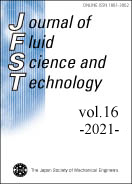Volume 16, Issue 1
Recent Advances in Flow Dynamics 2019
Displaying 1-9 of 9 articles from this issue
- |<
- <
- 1
- >
- >|
Recent Advances in Flow Dynamics 2019
-
2021Volume 16Issue 1 Pages JFST0001
Published: 2021
Released on J-STAGE: January 01, 2021
Download PDF (703K)
Papers
-
2021Volume 16Issue 1 Pages JFST0002
Published: 2021
Released on J-STAGE: January 01, 2021
Download PDF (3557K) -
2021Volume 16Issue 1 Pages JFST0003
Published: 2021
Released on J-STAGE: January 01, 2021
Download PDF (5057K) -
2021Volume 16Issue 1 Pages JFST0004
Published: 2021
Released on J-STAGE: January 01, 2021
Download PDF (1706K) -
2021Volume 16Issue 1 Pages JFST0005
Published: 2021
Released on J-STAGE: January 01, 2021
Download PDF (2184K) -
2021Volume 16Issue 1 Pages JFST0006
Published: 2021
Released on J-STAGE: January 01, 2021
Download PDF (2579K) -
2021Volume 16Issue 1 Pages JFST0007
Published: 2021
Released on J-STAGE: January 01, 2021
Download PDF (3074K) -
2021Volume 16Issue 1 Pages JFST0008
Published: 2021
Released on J-STAGE: January 01, 2021
Download PDF (4392K) -
2021Volume 16Issue 1 Pages JFST0009
Published: 2021
Released on J-STAGE: January 01, 2021
Download PDF (5153K)
- |<
- <
- 1
- >
- >|
